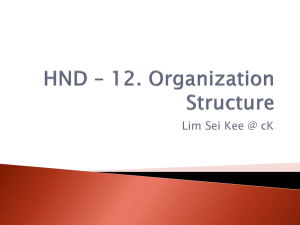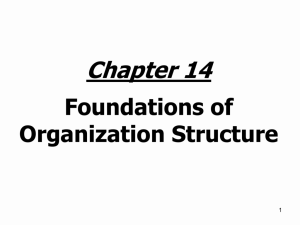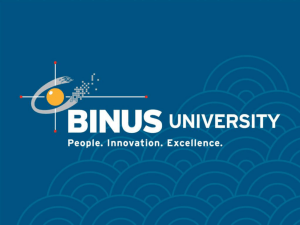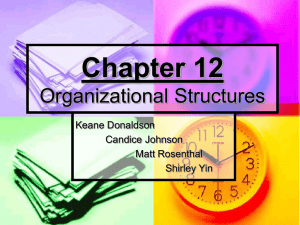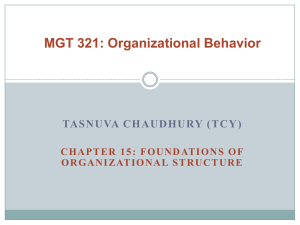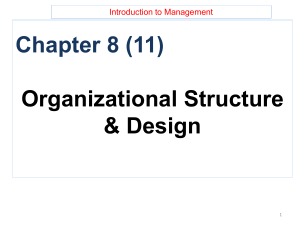Organizational Structure (cont'd) Authority
advertisement
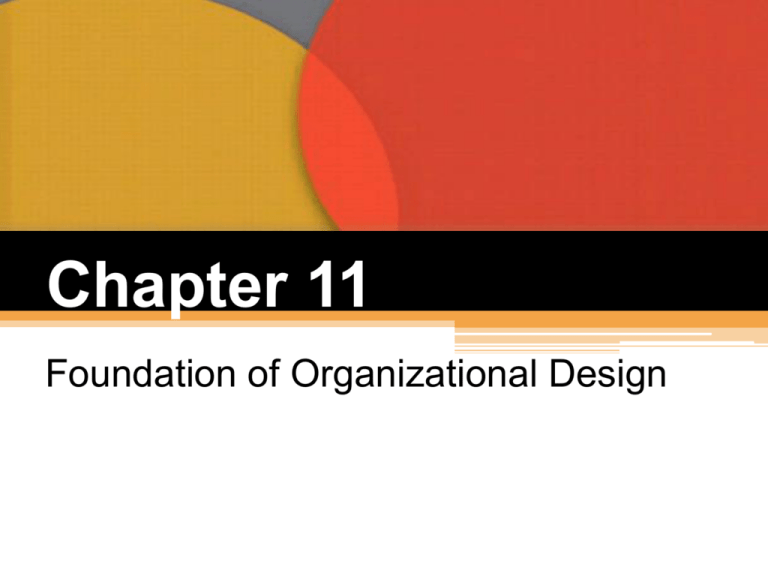
Chapter 11 Foundation of Organizational Design Purposes of Organizing • Divides work to be done into specific jobs and departments. • Assigns tasks and responsibilities associated with individual jobs. • Coordinates diverse organizational tasks. • Clusters jobs into units. • Establishes relationships among individuals, groups, and departments. • Establishes formal lines of authority. • Allocates and deploys organizational resources. Organizational Structure Work Specialization The degree to which tasks in the organization are divided into separate jobs with each step completed by a different person. Overspecialization can result in human diseconomies from boredom, fatigue, stress, poor quality, increased absenteeism, and higher turnover. Departmentalization by Type Functional Grouping jobs by functions performed Product Grouping jobs by product line Geographical Grouping jobs on the basis of territory or geography Process Grouping jobs on the basis of product or customer flow Customer Grouping jobs by type of customer and needs Organizational Structure (cont’d) Chain of Command The continuous line of authority that extends from upper levels of an organization to the lowest levels of the organization and clarifies who reports to whom. Organizational Structure (cont’d) Authority The rights inherent in a managerial position to tell people what to do and to expect them to do it. Line authority: Authority that entitles managers to direct the work of an employee Staff authority: positions with some authority that have been created to support, assist and advise those holding line authority Organizational Structure (cont’d) Responsibility The obligation or expectation to perform. Unity of Command The concept that a person should have one boss and should report only to that person. TODAY’S VIEW: Although early management theorists (Fayol, Weber, Taylor, Barnard, and others) believed that chain of command, authority (line and staff), responsibility, and unity of command were essential, times have changed. Those elements are far less important today. Organizational Structure (cont’d) Span of Control The number of employees who can be effectively and efficiently supervised by a manager. TODAY’S VIEW. The contemporary view of span of control recognizes that there is no magic number. Many factors influence the number of employees that a manager can efficiently and effectively manage. These factors include the skills and abilities of the manager and the employees, and the characteristics of the work being done Organizational Structure (cont’d) Centralization The degree to which decision making is concentrated at upper levels in the organization. Organizations in which top managers make all the decisions and lower-level employees simply carry out those orders. Decentralization Organizations in which decision making is pushed down to the managers who are closest to the action. Employee Empowerment Increasing the decision-making authority (power) of employees. Factors that Influence the Amount of Centralization and Decentralization • Apply more Centralization when: Environment is stable. Lower-level managers are not as capable or experienced at making decisions as upper-level managers. Lower-level managers do not want to have a say in decisions. Decisions are relatively minor. Organization is facing a crisis or the risk of company failure. Company is large. Effective implementation of company strategies depends on managers retaining say over what happens. • Apply more Decentralization when: Environment is complex, uncertain. Lower-level managers are capable and experienced at making decisions. Lower-level managers want a voice in decisions. Decisions are significant. Corporate culture is open to allowing managers to have a say in what happens. Company is geographically dispersed. Effective implementation of company strategies depends on managers having involvement and flexibility to make decisions. Formalization: Formalization refers to how standardized an organization’s jobs are and the extent to which employee behavior is guided by rules and procedures. In highly formalized organizations, there are explicit job descriptions, numerous organizational rules, and clearly defined procedures covering work processes. Employees have little discretion over what’s done, when it’s done, and how it’s done. Mechanistic (Bureaucratic) Vs Organic Organization • High specialization • Cross-functional teams • Rigid departmentalization • Cross-hierarchical teams • Clear chain of command • Narrow spans of control • Centralization • High formalization • Free flow of information • Wide spans of control • Decentralization • Low formalization Traditional Organizational Designs Simple structure Low departmentalization, wide spans of control, centralized authority, little formalization Functional structure Departmentalization by function Operations, finance, marketing, human resources, and product research and development Divisional structure Composed of separate business units or divisions with limited autonomy under the coordination and control the parent corporation. Strengths and Weaknesses of Traditional Organizational Designs Contemporary Organizational Designs Team structures The entire organization is made up of work groups or selfmanaged teams of empowered employees. Matrix and project structures Specialists from different functional departments are assigned to work on projects led by project managers. In project structures, employees work continuously on projects; moving on to another project as each project is completed. Contemporary Organizational Designs Boundaryless Organization An flexible and unstructured organizational design that is intended to break down external barriers between the organization and its customers and suppliers. Removes internal (horizontal) boundaries: Eliminates the chain of command Has limitless spans of control Uses empowered teams rather than departments Eliminates external boundaries: Uses virtual, network, and modular organizational structures to get closer to stakeholders. Removing External Boundaries Virtual Organization An organization that consists of a small core of full-time employees and that temporarily hires specialists to work on opportunities that arise. Network Organization A small core organization that outsources its major business functions (e.g., manufacturing) in order to concentrate on what it does best. Modular Organization A manufacturing organization that uses outside suppliers to provide product components for its final assembly operations.
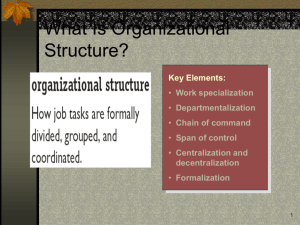
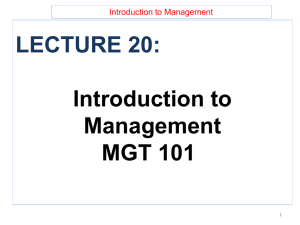
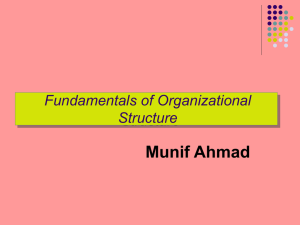
![[SUMMARY] Manajemen (Chapter 10)](http://s3.studylib.net/store/data/008743248_1-4e2b946756cf43cea567b50ee8fe6208-300x300.png)
